Introduction
The fact that properly designed mise-en-scenes play a crucial role in emphasizing the significance of a particular movie’s semantic content has been traditionally considered one of the most important cinematographic conventions. As it was pointed out by Thomson (2008), “Misé en scène… is used to trigger emotional responses that, in turn, reinforce the significance of narrative events” (p. 123). Therefore, it does not come as a particular surprise that the majority of cult-movies do, in fact, feature carefully constructed mise-en-scenes, which provide viewers with discursive connotations to the explored themes and motives. In this paper, I will aim to substantiate the validly of an above idea in regards to Milos Forman’s 1984 film Amadeus, which is being defined by the American Film Institute as the one among the 20th century’s 100 greatest movies.
Analytical Part
Ever since the early days of cinematography, film-makers faced the challenge of providing their movies with proper contextual undertones, which in turn were assumed to increase these movies’ emotional appeal. For example; whereas, early films featured a 1.33:1 aspect ratio, contemporary movies feature a wide-screen aspect ratio of 2.35:1. This particular aspect ratio allows directors to ensure the integrity of featured mise-en-scenes, which in turn helps viewers to assess the actual significance of a screen-action on a variety of different levels.
The technique of mise-en-scene relates to the technique of montage-editing. In fact, very often, the characteristics of a particular mise-en-scene are being defined by the nature of a director’s approach to editing (formalist, realist, or classical). For example; whereas, the so-called ‘open form’ format of designing mise-en-scenes is best suited for classically, and realistically edited movies, the ‘closed-form’ format is being commonly utilized in formalistically edited films.
There can be few doubts as to the fact that properly designed mise-en-scenes significantly increase the extent of a concerned film’s appeal to the audience. This is because viewers’ exposure to a particular mise-en-scene allows them to relate to the film’s action on the emotional level – hence, mise-en-scenes’ importance. Even early film-makers were well aware of this fact, which is why many black and white movies feature dramatic juxtapositions of light and darkness. Contemporary directors, however, are being in a position to utilize a variety of other techniques, meant to ensure their movies’ mise-en-scenic wholesomeness, such as emphasizing a particular color, for example.
The watching of Forman’s Amadeus leaves very few doubts as to the fact that the director utilized a clearly defined classical approach to film’s editing. The key features of this type of cinematographic editing are: the spatial integrity of the plot, the presence of prolonged takes, and the fact that even particularly short shots featured in this film are being psychologically interconnected. In its turn, Forman’s deployment of a classical editing-methodology, explains the specifics of how he went about constructing film’s most distinctive mise-en-scenes.
For example, there is a memorable scene, in which Salieri (F. Murray Abraham) brags about being in a position to give music lessons to Emperor Joseph himself, ‘Night after night, I sat right next to the Emperor of Austria, playing duets with him’ (00.13.35). Even though that this Salieri’s statement can be best described as being rather emotionally neutral (Salieri simply stresses out that he was able to secure a well-paid and prestigious job), the corresponding visual mise-en-scene provides viewers with the insight into the sheer size of Salieri’s ego. Apparently, Salieri used to think of himself as being nothing less than the Emperor’s close friend.
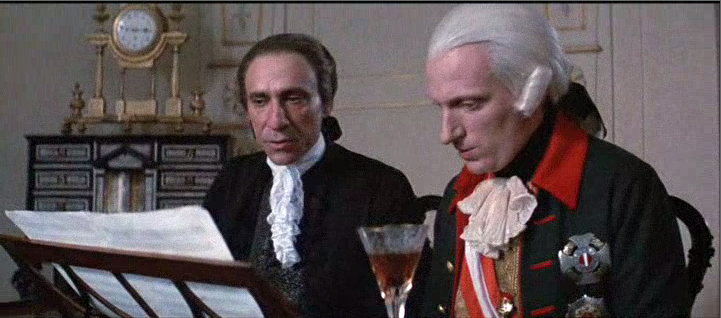
The reason for this is apparent – in this particular mise-en-scene, Salieri and Emperor Joseph are not only being represented at the frame’s center in a strongly synchronous manner, but they also appear being equally preoccupied with playing music – hence, a strong spirit of parallelism. The measure of ‘closeness’ between these two characters is being emphasized even further by the deployed ‘intimate’ proxemic pattern – Salieri and Emperor Joseph are being situated no further than 18 inches apart from each other (Hall, 1966, p.113).
Given the fact that Amadeus‘s plot unravels in the late 18th century’s Vienna, it was a matter of crucial importance for Milos Forman to ensure the historical authenticity of the explored themes and motifs. In its turn, this explains the ‘open form’ format of the movie’s panoramic mise-en-scenes. The deployment of this particular format is usually concerned with directors’ strive to enable viewers to savor the genuineness of a background setting. According to Giannetti (2001), “In terms of visual design, open form emphasizes informal, unobtrusive compositions. Often, such images seem to have no discernible structure and suggest a random form of organization. Objects and figures seem to have been found rather than deliberately arranged” (p. 83). Even a brief glimpse at the panoramic mise-en-scene below substantiates the full legitimacy of Giannetti’s suggestion, in this respect.
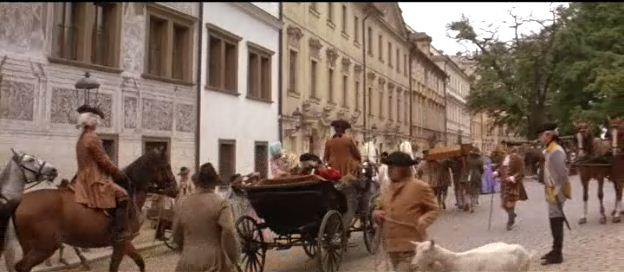
In Amadeus, there are many scenes in which young Mozart is shown socializing with the representatives of the Viennese social elite. Given the fact that, according to the fashion conventions of the day, men and women of high social prominence had to wear white-powdered hairpieces, it would make it challengeable for viewers to be able to distinguish the film’s main character from the secondary ones. This is the reason why the mise-en-scene of the film takes, in which Mozart (Tom Hulce) mingles with virtually indistinguishable wig-wearing Viennese aristocrats, features the main character in a funky-looking pinkish hairpiece.
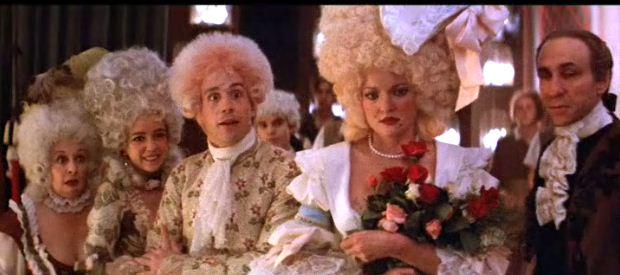
This, of course, helped viewers to pay foremost attention to the character of Mozart. Moreover, this also helped Forman to accentuate Mozart’s eccentricity – the psychological trait of extraordinarily gifted individuals (Welsch, 1997, p. 103).
As was implied earlier, in Amadeus Forman strived to provide a psychological characterization to just about all movie’s characters. In its turn, this explains why the mise-en-scenes of film’s many takes are being concerned with the director utilizing a play between light and darkness as a mean of achieving a number of various dramatic effects, which enlighten viewers on the essence of major characters’ psychological makeup. The validity of this suggestion can be best illustrated in regards to the scene in which crazed Salieri admits to the priest of having hated Mozart with utter passion, “My heart was filling up with such hatred for that little man… For the first time in my life, I began to know really violent thoughts” (00.47.17).
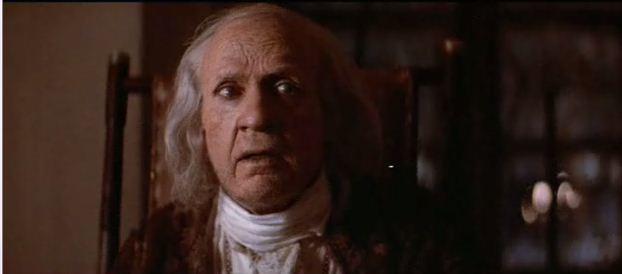
As it can be seen on the above screenshot of this take, its mise-en-scene has been designed in a manner to emphasize Salieri as an individual endowed with two mutually incompatible psyches: the psyche of a talented musician, who would never consider causing harm to a fellow human being, and the psyche of a madman, capable of committing a murder. This is because; whereas the left half of Salieri’s face is being illuminated with light (representing sanity), the right side of his face is being submerged in darkness (representing insanity).
According to Giannetti, the compositional subtleties of a particular mise-en-scene often highlight the involved characters’ social status, “The area near the top of the frame can suggest ideas dealing with power, authority, and aspiration… The areas near the bottom of the frame tend to suggest meanings opposite from the top: subservience, vulnerability, and powerlessness” (p. 52). Therefore, it does not come as a particular surprise that in his film Forman had made a point in placing characters near the bottom of the frame, every time he wanted to emphasize the sheer extent of their social insignificance. For example, in the scene where Mozart’s landlady tries to bring Emperor’s attention to the fact that she provides quarters to his favorite composer, her spatial positioning in the frame leaves very few doubts as to the fact that, despite her fashionable appearance, she cannot possibly aspire to be socially lifted.
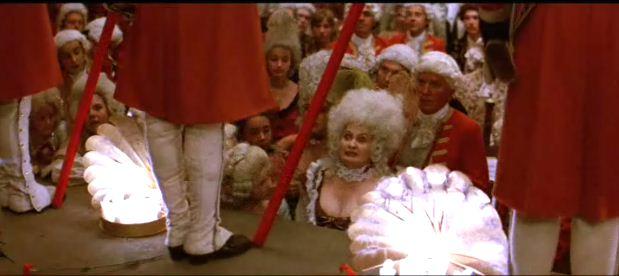
The aesthetic pleasure that people experience, while watching a particular movie, often comes as a result of them being provided with an opportunity to assess the significance of a particular plot’s development through the eyes of this movie’s characters. Apparently, while being provided with such an opportunity, viewers grow emotionally attached to the action, seen on the screen. The watching of Forman’s Amadeus is particularly reflective of the legitimacy of this suggestion because it features a number of scenes in which the authenticity of an ongoing cinematic action is being strengthened by the mean of a director having adopted an intellectually honest stance towards the members of a viewing audience. That is, on many occasions, the mise-en-scenes of film’s takes imply viewers being able to mentally reconstruct what appears to be the missing part of a ‘framed reality.’ For example, in the scene where Constanze (Elizabeth Berridge) hides under the table from her future husband, viewers only get to see Mozart’s legs, with the sight of his upper body being obstructed by the tablecloth.

This, however, does not undermine the integrity of the framed action, but on the contrary – it stresses out its authenticity. Just as it is being the case with Constanze, who anticipates being found by her fiancé, viewers anticipate for the identity of a mysterious stranger to be revealed to them. By doing it, they get to experience a particularly strong cinematic pleasure. As it was pointed out by O’Connor (2004), “Perceptions become cinematic when the field of visibility is opened to its virtual milieu beyond the dimensions of the frame. This supplement to the field of visibility is not so much seen as it is sensed and anticipated, in the same way, that we sense a depth to the world” (p. 109). This serves as an additional indication of the fact that in Amadeus, Forman proved himself being thoroughly aware of properly constructed mise-en-scenes’ ability to serve the role of particularly effective informational mediums.
Conclusion
The earlier provided analysis of how Forman went about designing his film’s most memorable mise-en-scenes, leaves very few doubts as to the fact that this director’s imaginative manner of ‘framing the reality’ contributed rather substantially to Amadeus ending up being put on the list of 20th century’s best movies. I believe that this conclusion is being thoroughly consistent with the paper’s initial thesis. In Amadeus, Forman did succeed in ensuring the mise-en-scenic integrity of the plot rather spectacularly. Even though the provided analysis of the director’s techniques, in this respect, is far from being considered complete, it does offer readers a certain insight into what accounted for these techniques’ effectiveness.
References
Forman, M. (Director). (1984). Amadeus [Motion picture]. United States: Orion Pictures.
Giannetti, L. (2001). Understanding movies (9th edition). Upper Saddle River: Prentice Hall.
Hall, E. (1966). The hidden dimension. New York: Anchor Books.
O’Connor, D. (2004). Mediated associations: Cinematic dimensions of social theory. Montreal: McGill-Queen’s Press.
Thomson, K. (2008). Continuum aesthetics: Aesthetics and film. London: Continuum International Publishing.
Welsch, T. (1997). Teaching Mise-en-Scene analysis as a critical tool. Cinema Journal, 36 (2), 101-106.